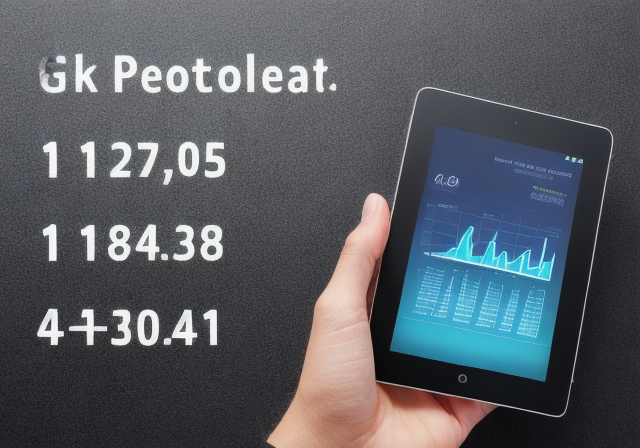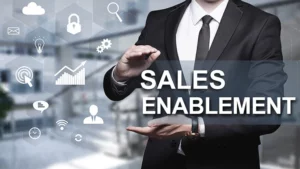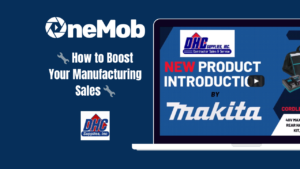What is Sales Enablement Content?
Sales enablement content refers to any type of content that helps sales teams engage with potential customers and close deals. This includes everything from blog posts and social media updates to case studies, whitepapers, and videos. The goal of sales enablement content is to provide salespeople with the tools, resources, and information they need to effectively communicate with prospects and move them through the sales funnel.
Why is sales enablement content important for businesses?
Creating effective sales enablement content is essential for any business looking to stay competitive in today’s crowded marketplace. By providing sales teams with well-crafted, targeted content, companies can help their salespeople build stronger relationships with potential customers and close more deals. Additionally, sales enablement content can help businesses establish themselves as thought leaders in their respective industries, giving them the credibility and authority needed to win customers’ trust.
Some examples of sales enablement content include:
- Case studies: These are real-world examples of how your company has helped other businesses solve problems or achieve their goals. They can be powerful tools for demonstrating the value of your product or service.
- Whitepapers: These are in-depth, research-based reports that explore a particular topic or issue in detail. They can be used to educate potential customers about industry trends or the benefits of a particular approach or solution.
- Product demos: These are live or recorded demonstrations of your product or service in action. They can be used to showcase the features and benefits of your offering and help potential customers understand how it can help them achieve their goals.
- Email templates: These are pre-written emails that salespeople can use to communicate with prospects. They can be customized to reflect the specific needs and interests of each individual prospect, making it easier to build relationships and move them through the sales funnel.

The power of sales enablement content
Creating effective sales enablement content requires a deep understanding of your target audience and their needs. By crafting content that speaks directly to these needs, businesses can help their sales teams build stronger relationships with potential customers and close more deals. Additionally, sales enablement content can help businesses establish themselves as thought leaders in their respective industries, giving them the credibility and authority needed to win customers’ trust.
Overall, sales enablement content is a powerful tool that can help businesses improve their sales performance and establish themselves as leaders in their respective industries. By creating content that resonates with potential customers and provides sales teams with the resources they need to effectively close deals, businesses can gain a competitive edge and achieve long-term success.

The benefits of sales enablement content
Effective sales enablement content can provide a number of benefits for businesses, including:
- Increased sales: By providing sales teams with the tools and resources they need to effectively communicate with prospects, businesses can improve their overall sales performance and close more deals.
- Improved customer relationships: By crafting content that speaks directly to the needs and interests of potential customers, businesses can build stronger relationships with them and establish themselves as trusted partners.
- Establishing leadership: By creating high-quality, thought-provoking content, businesses can establish themselves as leaders in their respective industries, gaining the respect and admiration of potential customers and industry peers alike.
Overall, sales enablement content is an essential component of any successful sales strategy. By providing sales teams with the information and resources they need to effectively engage with potential customers, businesses can achieve long-term success and establish themselves as leaders in their respective industries.
Creating Effective Sales Enablement Content
Now that you know what sales enablement content is, it’s time to create your own. However, before diving in, it’s essential to identify your target audience. Knowing your audience will help you determine the type of content that will resonate with them and ultimately drive sales. Take the time to research and understand your target audience’s demographics, pain points, and challenges. This will help you create content that speaks directly to their needs and interests.
The Different Types of Sales Enablement Content
There are various types of sales enablement content, each with its own unique purpose. The most common types of sales enablement content include:
- Case Studies: These are in-depth stories that showcase how your product or service has helped your customers.
- Whitepapers: These are authoritative reports that provide a deep dive into a particular topic or issue.
- Infographics: These are visual representations of data or information that help simplify complex concepts.
- Webinars: These are live or pre-recorded presentations that provide valuable insights into a particular topic or issue.
Tips for Creating High-Quality Content
Creating high-quality sales enablement content isn’t easy, but it’s essential to drive sales and help your team succeed. Here are a few tips to keep in mind:
- Focus on Your Audience: Always keep your target audience in mind when creating content. Speak directly to their needs and interests.
- Keep It Simple: Avoid using jargon or technical terms that your audience may not understand. Instead, focus on clear, concise language that’s easy to digest.
- Make It Visually Appealing: Use images, videos, and other visual elements to break up text and make your content more engaging.
- Provide Value: Your content should provide value to your audience. Whether it’s solving a problem or providing insights, always aim to provide value in your content.
By following these tips and creating high-quality sales enablement content, you can help your team succeed and drive sales for your business.

Remember, sales enablement content is all about providing your sales team with the tools they need to succeed. By creating high-quality content that speaks directly to your target audience’s needs and interests, you can help your sales team close more deals and drive revenue for your business.
Distributing Sales Enablement Content
Creating top-notch sales enablement content is only half the battle. If no one sees it, it’s not going to make a difference. That’s why distribution is crucial. But with so many channels available, how do you decide where to focus your efforts?
The Most Effective Channels for Distributing Sales Enablement Content
One effective way to distribute content is through email. It’s a direct and personal channel that allows you to reach your audience right where they are. Social media platforms like LinkedIn and Twitter can also be powerful channels for reaching your target audience. Be sure to tailor your content to each platform and engage with your audience by responding to comments and messages.
Another channel to consider is your company blog. Share your sales enablement content in blog posts to educate your audience and establish your brand as a thought leader in your industry. You can also repurpose your content into webinars or podcasts to reach a wider audience.
How to Measure the Success of Your Content Distribution Efforts
Measuring the success of your content distribution efforts is essential to improving your strategy. Track metrics such as website traffic, click-through rates, and engagement on social media. This will help you understand what’s working and what’s not, so you can make data-driven decisions about where to focus your efforts.
Another way to measure success is to survey your audience. Ask them how they found your content and what they thought of it. This will give you valuable insights into how your audience interacts with your content and what you can do to improve it.
Best Practices for Promoting Your Content
When promoting your content, it’s important to keep your audience in mind. Make sure your messaging is tailored to their needs and interests. Use attention-grabbing headlines and visually appealing images to draw them in. Be sure to include a clear call-to-action that tells them what to do next.
Another best practice is to leverage your network. Share your content with your colleagues and industry peers and ask them to share it with their networks as well. This will help you reach a wider audience and establish your brand as a thought leader in your industry.
Remember, distributing sales enablement content is all about getting it in front of the right people. By focusing on the most effective channels, measuring your success, and following best practices for promotion, you can ensure your content reaches and resonates with your target audience.

Image: Distributing sales enablement content
Sales Enablement Content for Different Stages of the Sales Funnel
Creating sales enablement content is a crucial aspect of any successful sales strategy. But not all content is created equal, especially when it comes to targeting different stages of the sales funnel. Understanding the different types of content that resonate with prospects at each stage of the funnel is key to creating a cohesive and effective content strategy.
Top-of-the-funnel content
The top of the funnel is where prospects become aware of your brand and start to research potential solutions to their problems. At this stage, your content should focus on building brand awareness and establishing your credibility as a thought leader in your industry. This can be achieved through blog posts, infographics, videos, and social media content. The goal is to provide helpful information that educates and inspires prospects, rather than trying to sell them on your product or service.
Visual content is especially effective at this stage, as it can grab attention and convey complex information quickly. For example, a well-designed infographic can help prospects understand a complex topic in a fun and engaging way. It’s also important to optimize your content for SEO, using relevant keywords and phrases that your target audience is searching for.
Middle-of-the-funnel content
Once prospects have moved past the awareness stage, they are ready to learn more about your product or service and how it can help solve their problems. Middle-of-the-funnel content should focus on providing more in-depth information about your product or service, while also addressing common objections and concerns that prospects may have.
Case studies, white papers, and webinars are all effective types of content at this stage. These pieces should highlight the specific benefits and features of your product or service, while also showcasing how you have helped other customers in similar situations. It’s also important to include clear calls-to-action that encourage prospects to take the next step in the sales process.
Bottom-of-the-funnel content
The bottom of the funnel is where prospects are ready to make a purchase decision. At this stage, your content should focus on providing the final push that convinces prospects to become customers. This may include product demos, free trials, and personalized proposals.
Email campaigns and retargeting ads are also effective at this stage, as they can help keep your brand top-of-mind and encourage prospects to take action. It’s important to make sure that your content is tailored to the specific needs and pain points of each prospect, and that you are providing the information they need to make an informed decision.
Creating a cohesive content strategy that targets each stage of the funnel
In order to create a successful content strategy that targets each stage of the funnel, it’s important to start by understanding your buyer personas and the specific pain points they are looking to solve. From there, you can develop a content plan that includes a mix of different types of content, tailored to each stage of the funnel.
You should also consider ways to repurpose and promote your content across different channels, such as social media, email, and your website. By creating a cohesive and integrated content strategy, you can ensure that your brand is consistently providing value to prospects at every stage of the sales funnel.
In conclusion, creating effective sales enablement content requires a deep understanding of your target audience and the different stages of the sales funnel. By developing a content strategy that targets each stage of the funnel, you can provide value to prospects at every step of the way, ultimately leading to more conversions and sales for your business.
Measuring the ROI of Sales Enablement Content
Creating and distributing sales enablement content is crucial for businesses looking to improve their sales performance. However, it’s equally important to track the success of your content to ensure that it’s delivering the expected results. Measuring the ROI of your sales enablement content can help you identify what’s working and what’s not, allowing you to make informed decisions about your content strategy.
The Importance of Measuring ROI
Measuring the ROI of your sales enablement content is essential for several reasons. Firstly, it helps you determine whether your content is generating the desired outcomes, such as increased sales, higher conversion rates, or improved customer engagement. This information can help you identify which types of content are most effective and optimize your content strategy accordingly.
Secondly, measuring ROI can help you justify the investment in your sales enablement content to stakeholders and decision-makers. By demonstrating the impact of your content on revenue and other key metrics, you can build a stronger business case for continued investment in content creation and distribution.
How to Track the Success of Your Sales Enablement Content
Tracking the success of your sales enablement content requires a combination of tools and techniques. Here are some of the most effective methods:
- Analytics: Use web analytics tools like Google Analytics to track traffic, engagement, and conversion rates for your content. This can help you identify which types of content are resonating with your audience and driving the most business value.
- Sales Metrics: Track sales metrics like revenue, deal size, and win rate to determine the impact of your content on the sales process. This can help you identify which types of content are most effective at moving prospects through the funnel and closing deals.
- Surveys and Feedback: Gather feedback from your sales team and customers to understand how your content is being received. This can help you identify areas for improvement and optimize your content strategy to better meet the needs of your audience.
Key Metrics to Measure
When measuring the ROI of your sales enablement content, there are several key metrics to consider. These include:
- Revenue: Track the revenue generated by your content to determine its impact on the bottom line.
- Conversion Rate: Measure the percentage of visitors who take a desired action, such as filling out a form or making a purchase, after engaging with your content.
- Time to Close: Track the average time it takes to close a deal after a prospect engages with your content to determine its impact on the sales process.
- Engagement: Measure engagement metrics like time on page, bounce rate, and social shares to determine how well your content is resonating with your audience.
By tracking these key metrics and using the insights gained to optimize your sales enablement content strategy, you can drive better business outcomes and improve your bottom line.
In conclusion, measuring the ROI of your sales enablement content is essential for ensuring that your content strategy is delivering the expected results. By using a combination of analytics, sales metrics, and feedback, you can identify which types of content are most effective at driving business value and optimize your strategy accordingly. By tracking key metrics like revenue, conversion rates, time to close, and engagement, you can demonstrate the impact of your content on the bottom line and build a stronger business case for continued investment in content creation and distribution.
Conclusion
As we’ve seen, sales enablement content is a crucial component of modern marketing strategies. By providing sales teams with the right tools and resources, businesses can empower their reps to engage customers with personalized, relevant content that drives conversions. However, creating and distributing effective sales enablement content requires a strategic approach and a deep understanding of your target audience.
Best Practices for Creating Sales Enablement Content
When creating sales enablement content, it’s important to keep in mind the needs and preferences of your target audience. Some best practices to follow include:
- Focus on the customer: Your content should be tailored to meet the needs and interests of your target audience. Make sure your messaging is clear, concise, and relevant to their pain points.
- Provide value: Your content should provide real value to your customers, whether that be in the form of educational resources, product demos, or thought leadership content.
- Make it visually appealing: Visual content is more engaging and memorable than text-based content alone. Incorporate images, videos, and interactive elements to make your content more engaging.
- Personalize your content: Use customer data to personalize your content and make it more relevant to each individual prospect.
Best Practices for Distributing Sales Enablement Content
Once you’ve created your sales enablement content, it’s important to have a plan in place for distribution. Some best practices to follow include:
- Use a centralized platform: A centralized platform like OneMob can help you manage and distribute your sales enablement content more effectively.
- Make it easily accessible: Your sales reps should be able to access your sales enablement content quickly and easily, whether that be through a mobile app or a web-based platform.
- Track engagement: Use analytics tools to track engagement with your sales enablement content. This can help you identify which pieces of content are resonating with your audience and which ones need improvement.
- Continually optimize: Use data insights to continually optimize your sales enablement content and distribution strategy. This will help you stay ahead of the curve and continue driving results.
By following these best practices, you can create and distribute sales enablement content that drives results and helps you stand out in a crowded marketplace. Remember, sales enablement content is an ongoing process, and it’s important to continually iterate and optimize your strategy to stay ahead of the curve.
Thank you for joining us on this journey to explore the world of sales enablement content. With the right strategy, tools, and resources, you can unlock the full potential of your sales team and drive meaningful results for your business.







